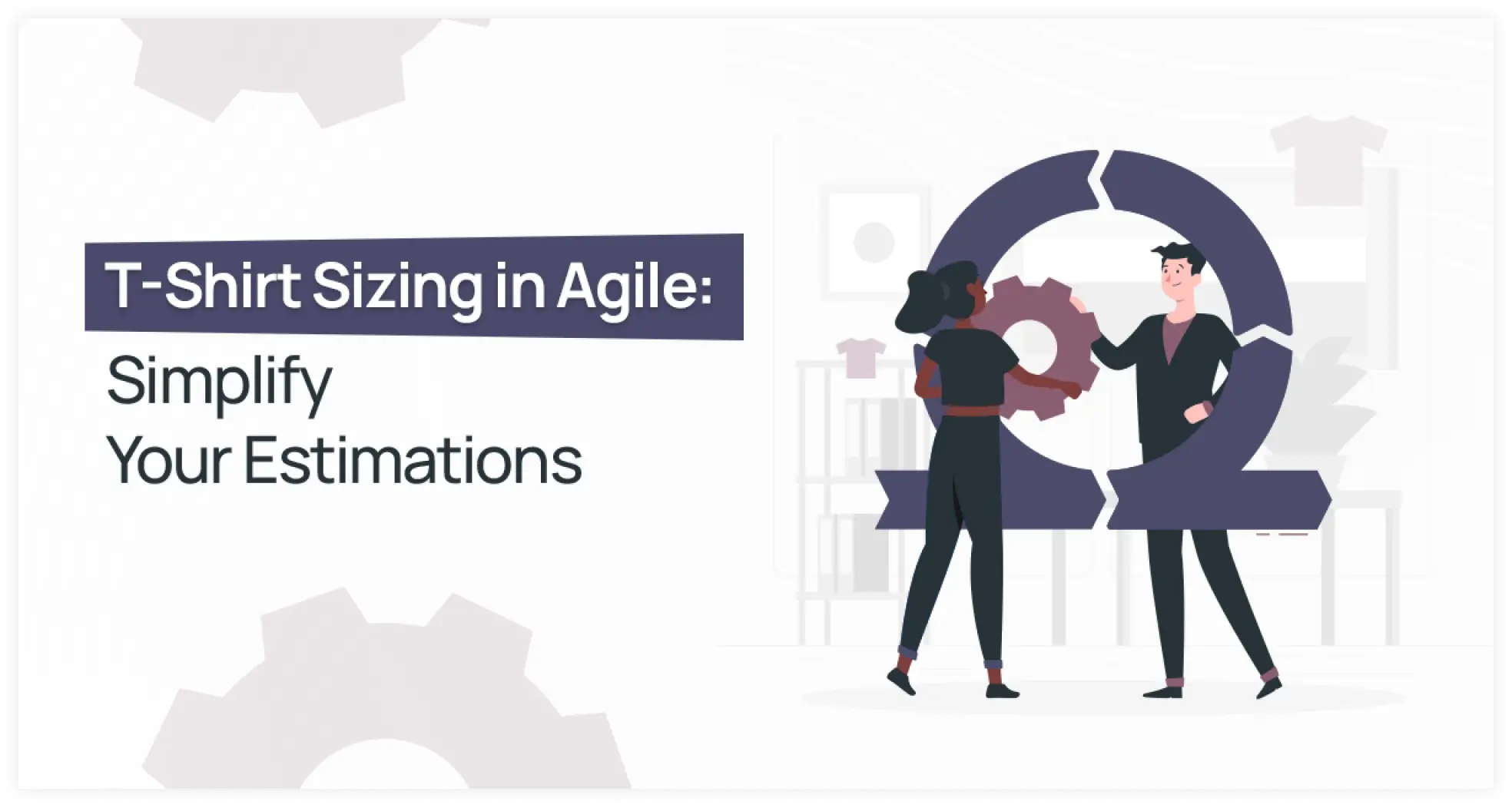
T-shirt sizing offers a simpler and more flexible approach for estimating the size or effort of tasks. Rather than focusing on time, it focuses on the task size. T-shirt sizing categorizes tasks based on their size, such as Small (S), for small projects and Large (L) for longer and important tasks that take more effort.
In this simple blog, we will explore the different aspects of T-shirt sizing in Agile. These aspects include what T-shirt sizing is in Agile, how to use it, how it works, and the important steps to implement it in Agile Projects.
What is T-Shirt Sizing in Agile?
The common technique used in Agile Project Management is T-shirt sizing. In simple words, T-shirt sizing is a project estimation and capacity planning tool that helps the organization track how much time or effort a task will take. The T-shirt sizing method involves assigning tasks based on sizes such as X, XL, L, and S based on the task.
Each size represents the task efforts and time the task will take. The project manager also uses the Fibonacci sizing that is only based on numerical values such as 1,2,3,4,5,6,7 etc. Relative estimation is the crucial and most important part of T-shirt sizing.
In relative estimation, the team member focuses on comparing the sizes of the tasks with one another instead of using the timeframes for different tasks for the completion of tasks.
How Does it Work?
T-shirt sizing does not represent specific numbers, but relative size categories, such as XS, S, M, L, or XL for tasks or user stories. The process looks like this:
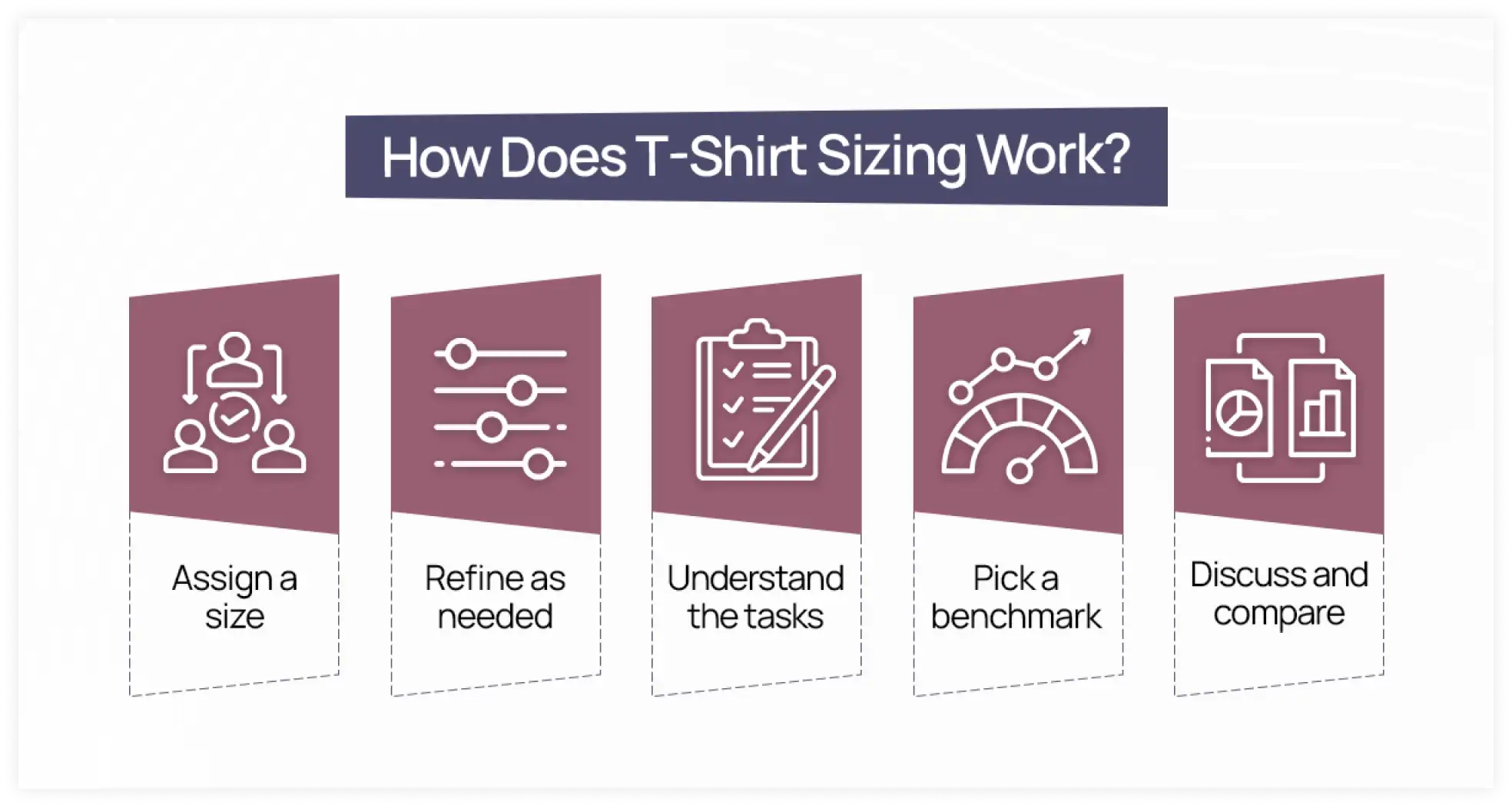
1. Understand the Tasks: The team walks through the tasks or user stories so that everyone has insight into what work needs to take place.
2. Pick a Benchmark: The team picks one task to set the bar (e.g., a “Medium” one) for comparison with everything else.
3. Discuss and Compare: For each task, the team discusses its complexity, effort, and uncertainties. Then, they compare it to the benchmark task to decide whether it’s smaller, larger, or about the same.
4. Assign a Size: Based on the discussion, the team assigns a size (e.g., S, M, L) to the task.
5. Refine as Needed: As new information emerges or tasks change, the team revisits and adjusts the sizes if necessary.
T-Shirt Sizing in Agile: Simplify Your Project Estimation
T-shirt sizing is the simple term in Agile Project Management used for estimating the size, complexity, and efforts required for the tasks or projects. T-shirt sizing in the Agile project refers to using the shirt sizes for the different sizes.
Each shirt size is the symbolic representation of the task of the project based on its shirt size on how much the task or project will take the time such as Extra Large (XL) for the task or project will take more time and effort to finalize. The Organisations and Project managers rely on shirt sizes instead of numerical values in this method.
Why is T-Shirt Sizing Important?
T-shirt sizing in Agile is not just a tool for estimating tasks; it’s a game-changer in how teams plan and execute projects. It’s a key part of transforming the way teams work together, offering much more than just simplicity and clearer communication.
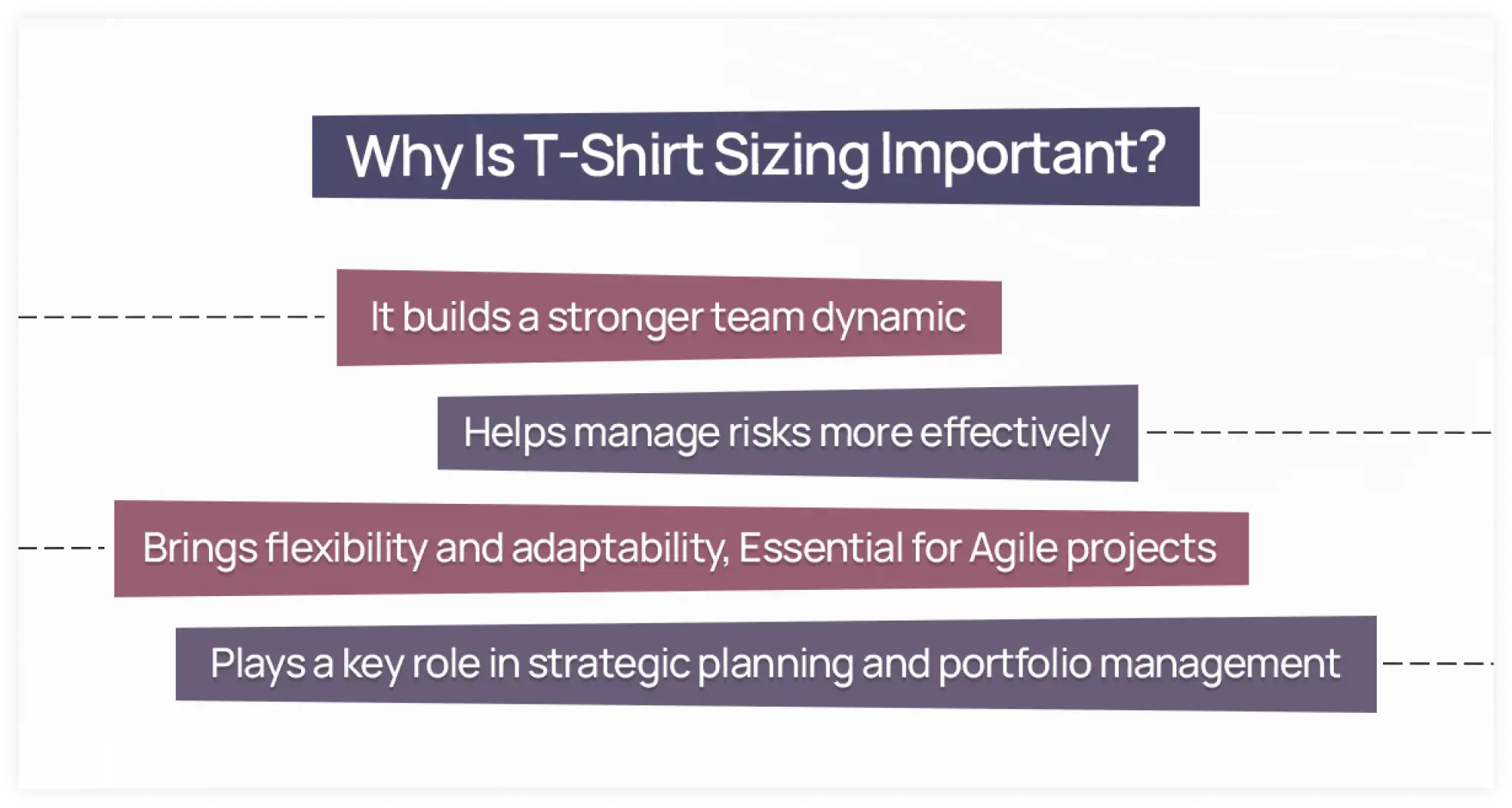
1. It builds a stronger team dynamic
T-shirt sizing takes the pressure off having to give exact numbers, using simple, relative sizes instead. This shift helps team members feel more comfortable and less stressed during planning, leading to more open discussions and honest input.
2. T-shirt sizing helps manage risks more effectively
T-shirt sizing makes it easier to spot larger, more complex tasks early on, allowing teams to plan and tackle potential challenges before they become problems. By breaking tasks into different sizes, teams can quickly identify high-risk items and address them proactively.
3. It brings flexibility and adaptability, essential for Agile projects
T-shirt sizing gives teams a clear view of project demands, making it easier to allocate resources and plan for the long term.
True to the Agile mindset, it offers the flexibility to adjust quickly as project needs change without the need for time-consuming re-estimations that more traditional, number-based methods require.
4. T-shirt sizing plays a key role in strategic planning and portfolio management
It provides a high-level overview of what’s necessary for a project, assisting managers with resource allocation and future project planning with a clearer understanding of the team’s velocity, capacity, and complexity. This panoramic view empowers organizations with a decisive competitive edge to commit to the future while ensuring the optimal deployment of resources for the greatest return.
T-Shirt Sizing Vs Story Points: Key Difference
The table below explores the key differences between T-Shirt Sizing and Story Points:
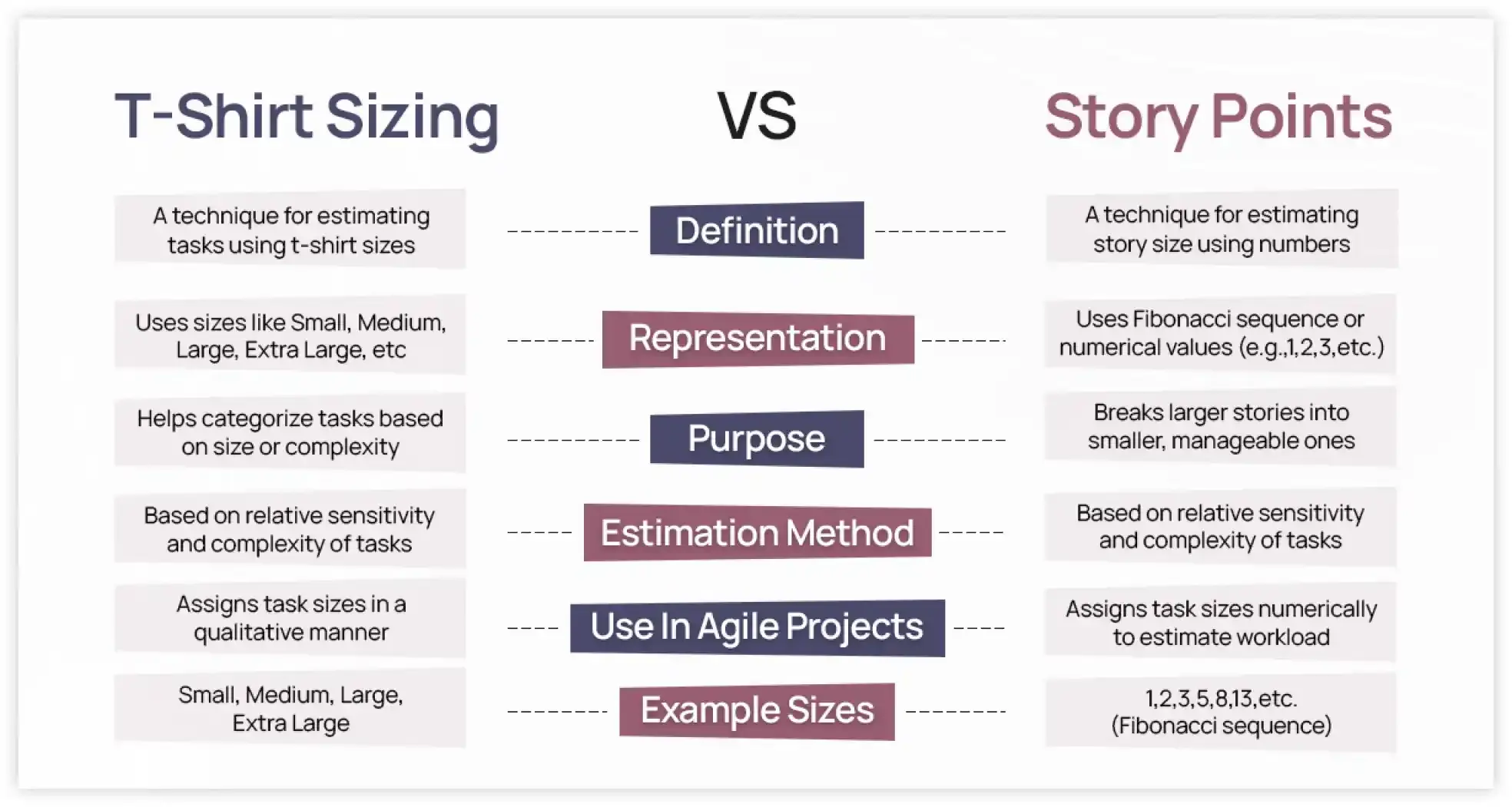
T-Shirt Sizing Estimation Examples For Agile Teams
Below are a few examples to understand how T-shirt sizing can be implemented in Agile Project Management.
A Small Task
Imagine you ask your team member to fix a minor bug in code that has already been found and isolated. This task doesn't need any extra responsibilities and external resources. You expect it to be fixed and completed within the next few hours. This is a small task and can be sized as Small (S) as it doesn't need extra effort and time.
A Medium Task
Imagine your client wants to add new features to their system that require collaboration between the design and development teams. Being the project manager you know that it won’t take a long time as the task is not too complex. However, the task demands the collaboration and teamwork of two different departments. This would be the Medium Size (M) task as it needs a lot more effort, responsibilities, and collaboration.
A Large Task with Extra Responsibilities
Now imagine a larger task. Your client asked you to improve the performance of the application which needs to be changed from the very beginning. There are many unknown high risks, including the third-party dependencies and the cross-functional collaboration across the different teams and the team members. This would be the Large (L) task based on its high risks, demanding specific planning and resources for a longer time.
Benefits of T-Shirt Sizing in Agile Project Management
Here is why T-shirt sizing is an important and valuable technique in Agile Project Management:
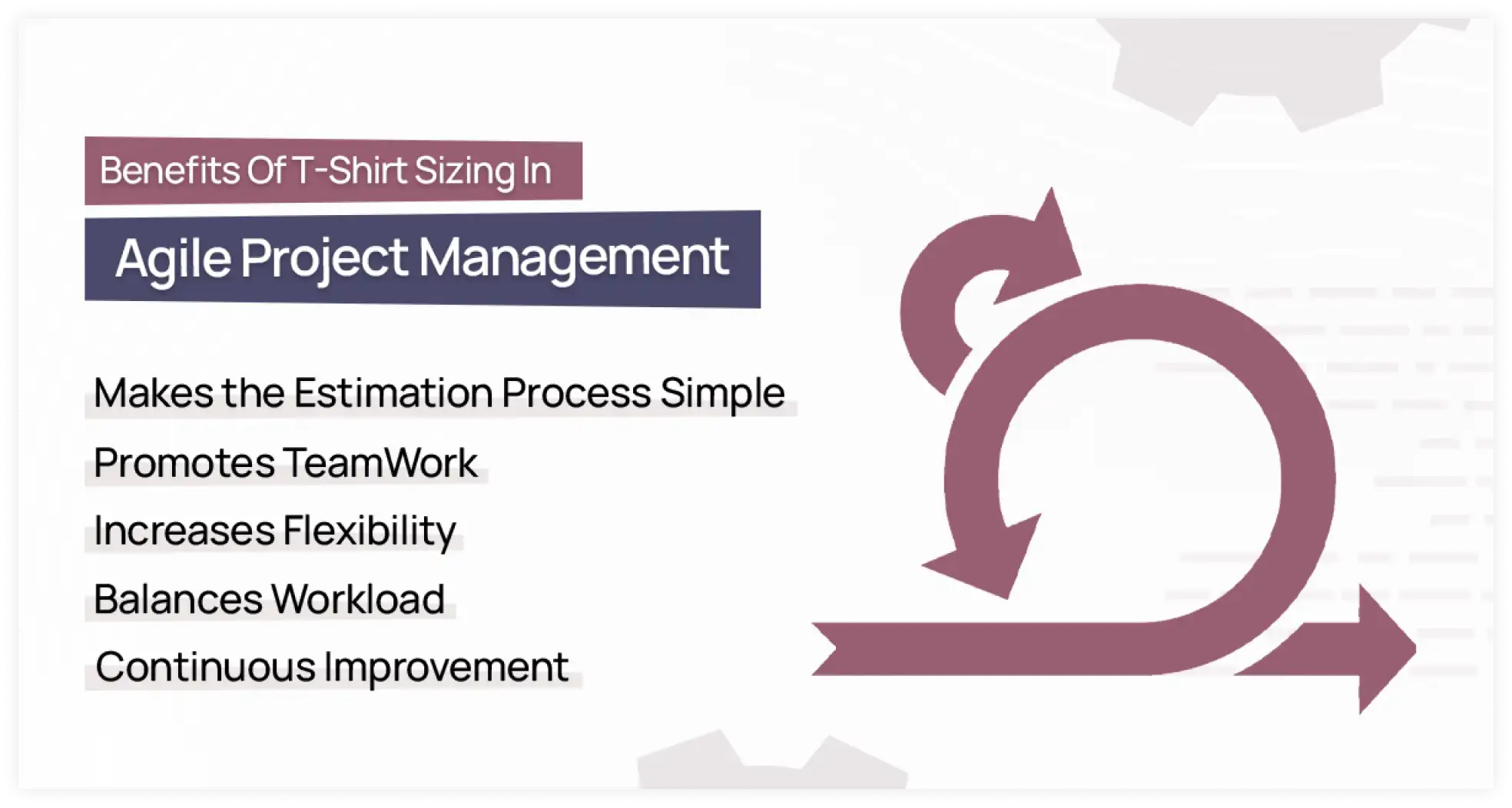
Makes the Estimation Process Simple
By focusing on the relative size of the task or project sizes rather than the exact time. T-shirt sizing makes the estimation process simple which was once over-complicated and complex.
Promotes TeamWork
Open communication and team collaboration is what T-shirt sizing encourages. Since the T-shirt sizing depends on the consensus, the team members from the different areas share their valuable insight, discuss their task complexities with each other, and are aligned on teamwork efforts. This helps create an environment that is feasible and can only be supported through the shared efforts of each team member.
Increases Flexibility
T-shirt sizing is not tied and is limited to rigid timeframes. The major strength of the T-shirt sizing is its flexibility. T-shirt sizing allows the organization, project managers, and team members to be more flexible toward unexpected challenges and changing priorities. The changing in priorities refers to something that was once considered smaller and won't take extra effort and time can be easily adjusted into something larger in size.
Balances Workload
As the task is assigned based on the sizes the project managers and team members can easily split the larger tasks and projects into something smaller. This ensures a more even and equal distribution of the efforts.
Continuous Improvement
With time when the team members become more familiar with the T-Shirt sizing they can easily refine their sizing process. The more they complete their tasks within the T-shirt sizing of Agile Project management the easier it becomes for them to know what each size represents. This leads to the continuous improvement of the estimation accuracy.
Frequently Asked Questions
1. How to determine the size of the Project?
To determine the size of the project, break it down into smaller sizes or story estimation to get a better result. Breaking down the project from the t-shirt sizing point of view the whole project will be in small, medium, or extra large while from the story estimation point of view the whole project will look like 1,2,3,4,5, etc based on the numbering. Numbers and sizing represent the task complexity, the time it will take, and the effort it needs.
2. What is T-shirt sizing agile epic?
The t-shirt sizing epic in the Agile projects means estimating the size of the large user story (epic) by using different sizes such as XL, S, M, L, etc. This approach helps the project managers and team members to quickly respond to the complexity of the task.
3. What is T-shirt sizing in business analysis?
In a business analysis t-shirt sizing is a quick way to assign the task and calculate the velocity and importance of the task based on the t-shirt sizes. This approach helps the team members to prioritize the task based on the shirt size without any detailed explanation.
Conclusion
In conclusion, T-shirt sizing is an important tool in Agile project management. It helps the organization, project managers, and team members to do the first and most important task on priority without causing any delays. By using the t-shirt sizing alone or alongside the story estimation, it helps the team members to contribute and distribute the even and equal workload and efforts.



















